
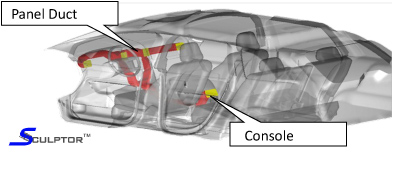
| FLOW TO REAR SEATS | +250% |
| PRESSURE DROP | -9% |
| PACKAGING Constraints | OK |
The automotive Heating, Ventilation and Air / Conditioning (HVAC) unit supplies air to the vehicle cabin interior through the panel duct and the consoled duct systems. These duct geometries should respect the packaging constraints imposed by devices and structures contained in the instrument panel and in the console frame: this turns the HVAC duct system shape design into a challenging task.
Geometry of an existing HVAC duct system had to be improved in a Ford vehicle, aiming at a substantial increase of the flow reaching the rear seats through the console duct, while respecting all the packaging constraints. Besides that, the reduction of the pressure drop would have been beneficial to reduce the vent energy consumption. Finally, design cost and time had to be minimized.
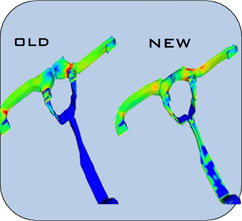 Sculptor™, coupled with a Multi-Objective Optimization code, allowed finding an optimal and feasible duct system shape over a few days, with only CFD the same optimization would have taken several weeks. With subtle shape modifications, a 250% increase of the console duct flow rate was reached. At the same time, pressure drop was decreased by 9%. This approach allowed to completely define the design in a few days. Moreover, Sculptor™ avoided time consuming operations on the Computer Aided Design (CAD) model and on the computation grid, since its morphing took place over the CFD model directly.
Sculptor™, coupled with a Multi-Objective Optimization code, allowed finding an optimal and feasible duct system shape over a few days, with only CFD the same optimization would have taken several weeks. With subtle shape modifications, a 250% increase of the console duct flow rate was reached. At the same time, pressure drop was decreased by 9%. This approach allowed to completely define the design in a few days. Moreover, Sculptor™ avoided time consuming operations on the Computer Aided Design (CAD) model and on the computation grid, since its morphing took place over the CFD model directly.

 The original HVAC ducts had to be shaped respecting the existing packaging constrains, imposed by devices and structures contained in the instrument panel and in the console frame. In particular, the rear seats' mass flow had to be substantially increased. Also the maximum pressure drop had to be decreased in order to downsize the volume of the vent.morphing took place over the CFD model directly.
The original HVAC ducts had to be shaped respecting the existing packaging constrains, imposed by devices and structures contained in the instrument panel and in the console frame. In particular, the rear seats' mass flow had to be substantially increased. Also the maximum pressure drop had to be decreased in order to downsize the volume of the vent.morphing took place over the CFD model directly.
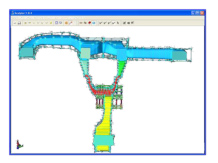 Sculptor™'s technology was applied over the Computational Fluid Dynamic (CFD) model of the duct system, to define its op-timal shape. The original mesh was im-ported and prepared for morphing. Twelve parameters controlling the shape of crucial areas were defined and set in a way that took into account the mentioned constraints.
Sculptor™'s technology was applied over the Computational Fluid Dynamic (CFD) model of the duct system, to define its op-timal shape. The original mesh was im-ported and prepared for morphing. Twelve parameters controlling the shape of crucial areas were defined and set in a way that took into account the mentioned constraints.
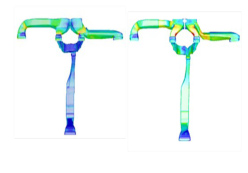 Shape Deformation (ASD) volumes, different fea-sible configurations were instantly generated by changing parameter values, without the need of re-creating the mesh. Such new configurations were then submitted to CFD and evaluated. Fi-nally, the configuration giving the best results was exported back as a CAD file, and con-structed by stereo lithography. This part was tested on the real HVAC unit, confirming the predicted improvements.
Shape Deformation (ASD) volumes, different fea-sible configurations were instantly generated by changing parameter values, without the need of re-creating the mesh. Such new configurations were then submitted to CFD and evaluated. Fi-nally, the configuration giving the best results was exported back as a CAD file, and con-structed by stereo lithography. This part was tested on the real HVAC unit, confirming the predicted improvements.
Sculptor™, coupled with a CFD code, allowed finding the optimal HVAC duct system shape in a few days, while CFD only would have taken several weeks. The total costs were 90% less with respect to the traditional design method. In the table below the breakdown of the costs is presented, based on the estimation of man-hour cost of ($90 / hour), CFD code hourly cost ($10.75 / hour) and a Sculptor™ hourly cost of ($10.75 / hour). 80 designs needed to be evaluated.
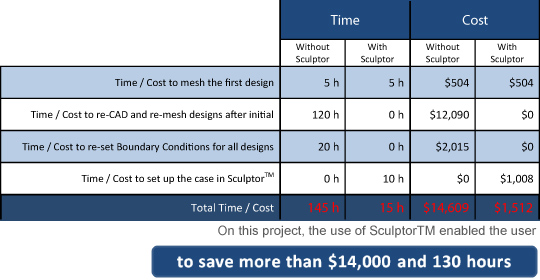
Sculptor™ is developed by Optimal Solutions Software LLC, based in Idaho, USA. The Optimal Solutions Management team is comprised of some of the most experienced CFD-based shape optimization personnel in the business. Since 1990, the re-search team has expended thousands of man-hours in design-ing and refining the Sculptor™ software program to its pre-sent form. Through the development of the Sculptor™ world-class, patent-pending product family, Optimal Solutions has been able to effectively address the current barriers that pre-vent the efficient use of digital simulation.
The team at Optimal Solutions Software is happy to perform a no-cost initial design assessment on your model. Contact us today and we will obtain the deformation constraints from you and demonstrate how Sculptor can save you time and money. We have worked with all sizes of companies and have NDA's in place with most major firms and can quickly get to work on your model.
 Sculptor enabled optimization of the HVAC design resulting in significantly improved performance with an 89 % time savings and a 90% cost savings to the customer as compared to other methods.
Sculptor enabled optimization of the HVAC design resulting in significantly improved performance with an 89 % time savings and a 90% cost savings to the customer as compared to other methods.

 Sculptor enabled an 8% increase of overall lift/drag ratio, a 90 % time savings, and a 91% cost savings to the customer as compared to other methods.
Sculptor enabled an 8% increase of overall lift/drag ratio, a 90 % time savings, and a 91% cost savings to the customer as compared to other methods.

 Sculptor enabled optimization of the aerodynamic design with a 90 % time savings and as compared to other methods.
Sculptor enabled optimization of the aerodynamic design with a 90 % time savings and as compared to other methods.
 Sculptor enabled the customer to match "hot" turbine blade models to "cold" shape with a 62 % time savings and a 62% cost savings to the customer when compared to other methods.
Sculptor enabled the customer to match "hot" turbine blade models to "cold" shape with a 62 % time savings and a 62% cost savings to the customer when compared to other methods.

 Sculptor enabled optimization of the high speed train design resulting in reduced drag, reduced emissions and improved efficiencies with an 85 % time savings and a 92% cost savings to the customer as compared to other methods.
Sculptor enabled optimization of the high speed train design resulting in reduced drag, reduced emissions and improved efficiencies with an 85 % time savings and a 92% cost savings to the customer as compared to other methods.

 Sculptor enabled evaluation of 124 design variants with an 86 % time savings and an 86% cost savings to the customer when compared to other methods.
Sculptor enabled evaluation of 124 design variants with an 86 % time savings and an 86% cost savings to the customer when compared to other methods.
